These are some of the most interesting cruise ship technology-related data and facts - engines, power, marine propulsion systems, fuel consumption of cruise ships, and something about pollution (in-article navigation links).
In 2020, IMO (International Maritime Organization) implements its global 0,5% sulfur cap on marine fuels. If not using scrubbers (pollution control devices), owners of older vessels must use as ship fuels either MGO (marine gas oil), ECA Category Fuels (low sulfur MGO), new modified fuels and blends, LNG (liquefied natural gas) or electric/battery power. Each fuel option is based on vessel type and age, routes/itineraries and powerplant. Most newbuild passenger ships are LNG-powered. World's largest seaports plus numerous smaller ports already have installed shoreside power capabilities providing shore-to-ship power supply to berthed vessels. In many ports, shorepower is in addition to LNG bunkering capabilities.
Cruise Ship Engine
Without a source of power, these huge cruise vessels would be nothing more than drifting aimlessly hotels. A large number of older ships use diesel reciprocating engines for generating power for propulsion. Cruise ship engine power is supplied through the transmission to the propeller shafts. These transmissions determine the revolutions of propellers. Modern ships use either diesel-electric engines or gas turbines as a source of power for propulsion, and for ship's systems. Some of the larger ships depend on two power sources - one for electrical power and one for propulsion.
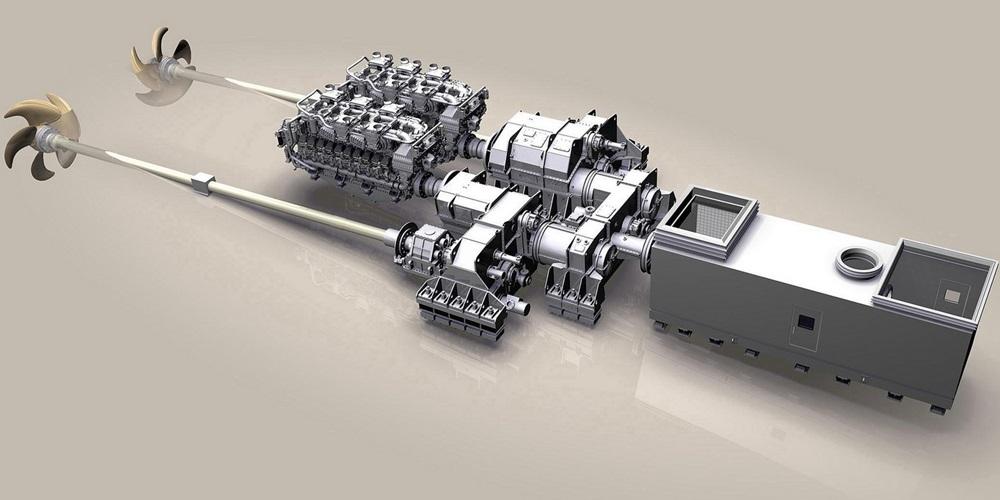
Gas turbine engines (being aero-derivative) generate heat which is transformed from mechanical energy into electricity. To achieve this, compressed air is fired in a combustion chamber. Hot exhaust is made over a turbine that spins to drive mechanically a shaft. The power can be used to spin the generators. The same way works diesel-electric engines, yet they use a direct drive system, not a turbine. The output shafts, to produce electrical power, are connected to generators.
Both engine types need a lot of fuel. Cunard QE2, for example, consumes daily 380 tons of fuel when traveling at 29 knots speed and carries fuel enough to sail for 12 days. Usually, ships fill up at various seaports and use fueling barges as floating gas stations. Vessels use lower-grade diesel which tends not to burn as purely as diesel-powered road-going vehicles.
All ships rely on propellers/screws to be pushed through the water, providing forward and reverse motion. Airplanes, for example, require tremendous propeller speeds to provide the forward motion, but ship propellers don't need to turn so fast and rely on torque power. Therefore, ships travel slowly and rarely top 30 knots (for more info follow our speed-link above).
Cruise ship engine room
The basic detail about the cruise ship engine room is its location. For stability, the ship's heaviest weights are at its lowest possible deck, and usually, engines are mounted above the keel. Ship's lowest decks are almost entirely full of machinery. An area creating enough power for driving such an enormous vessel through water needs to be really big - very often engine rooms occupy at least three decks. Rather than long halls stretching the length of hulls, machinery is almost always divided into smaller compartments - one for the main engines, another for the heating/air-conditioning system. This compartmentalization is for safety reasons. If a penetration to the hull or fire happens, multiple compartments help contain the damage. The next photo shows the engine room of RCI's Oasis-Class vessels.
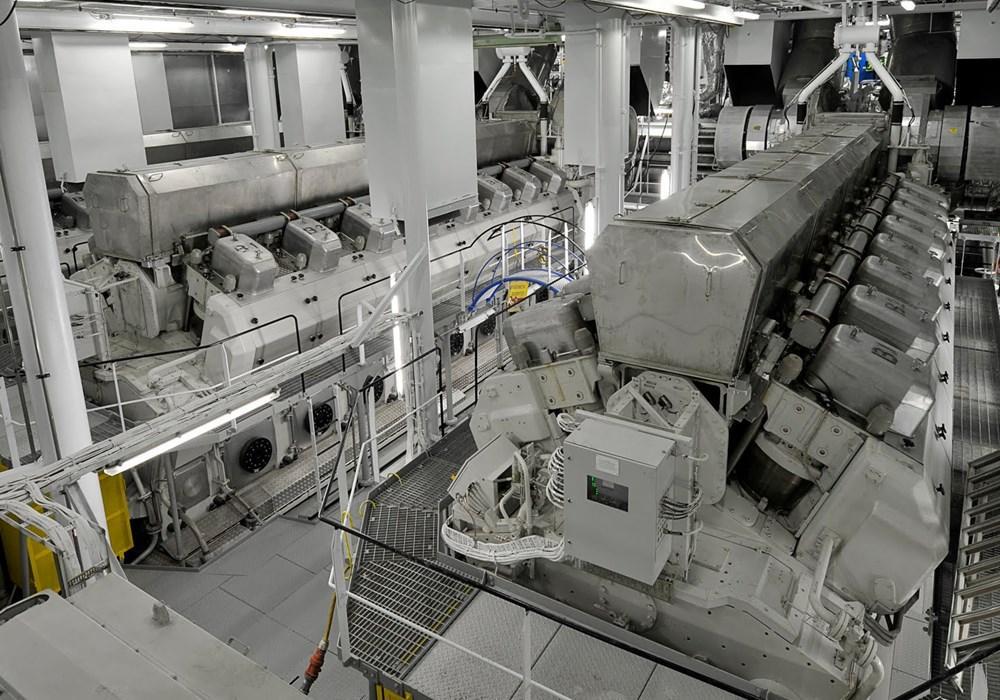
Rarely, engines are not placed at the ship's bottom. RMS Queen Mary 2's four main diesel engines are above the keel, with two smaller gas turbines on top-deck (aft of the funnel). It was not unusual for older liners to have 2 engine rooms. Gradually, technology allowed the consolidation of these spaces. However, current maritime legislation requires vessels to have equipment duplication and 2 engine rooms.
In May 2015, Wartsila Corporation and Carnival Corporation partnered to optimize cruise ship engine room operations of all 101 ships across the corporation's 9 brands. The deal was signed by Micky Arison (Carnival's Chairman) and Bjorn Rosengren (Wartsila's President and CEO). The plan included installing Wartsila's latest marine solutions, first tested on several Carnival Cruise Line vessels in pilot projects. The new systems and technologies included engine control and monitoring systems, safety and fuel efficiency equipment.
Wartsila's "Asset Performance Optimization Solution" package allows obtaining optimal performance from Wartsila marine diesel engines, recommends how to deal with potential issues, maximizes ship performance, ensures full-capacity systems operations, increases the predictability of fuel management and maintenance needs. Wartsila's fuel engine package was specifically designed to reduce fuel consumption.
Wartsila Marine technologies aim to optimize ship performance, but also allow to locate deviations from normal parameters of equipment and engines. This allows emerging problems and engine fault sources to be fixed before they occur.
In November 2024, Wartsila introduced the NextDF for the dual-fuel engine 25DF (first deliveries scheduled for 2025-H2). When 25DF operates on LNG, the NextDF reduces methane/CH4 emissions to ~2% and also nitrogen oxide/NOx emissions.
Conventional diesel cruise ship engine
Today's direct-drive diesels feature one main advantage - the option to use a shaft generator, which is a device using the circular motion of the propeller shaft in order to generate the electricity needed for hotel services, like cooking and lighting.
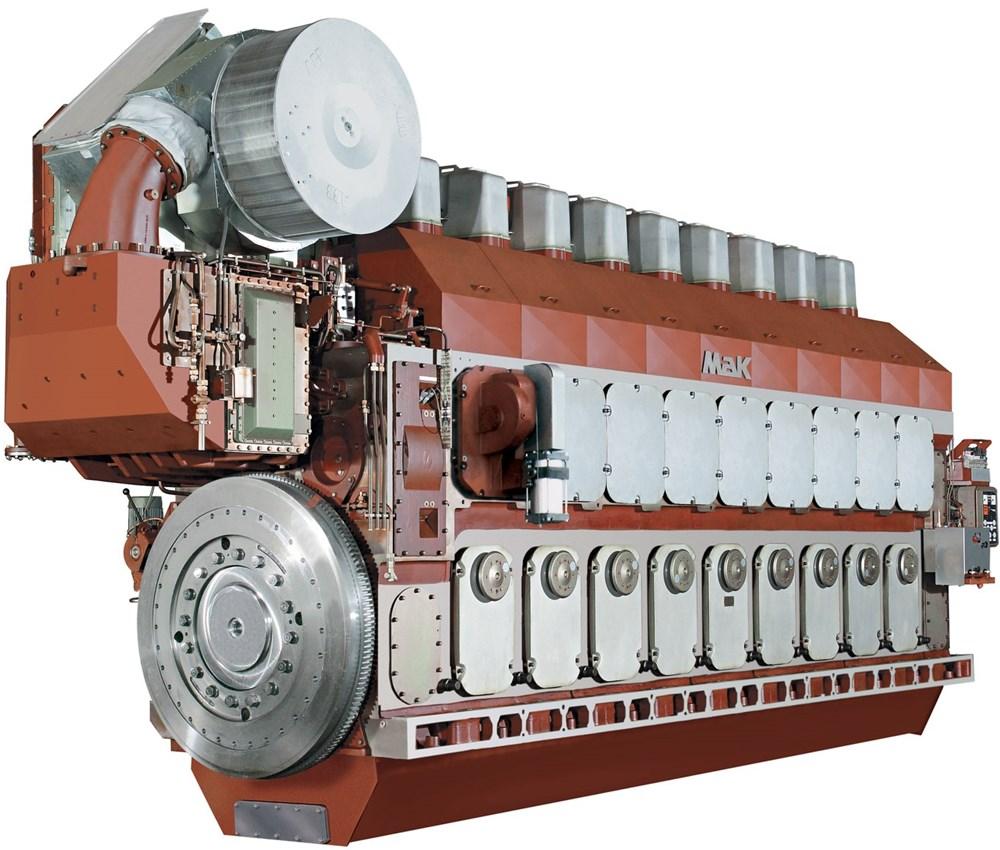
Shaft generators can be used only while the ship is moving with a fairly constant cruising speed. This is what the NCL Epic cruise ship engine looks like:
Diesel-electric cruise ship engine
Almost all new ships feature a diesel-electric propulsion form. On these ships, main engines are not connected to propeller shafts, and instead of it they are directly connected to big generators in order to produce electricity, which is sent in turn to electric motors, that then power and help turn the propellers. The main advantage of the diesel-electric cruise ship engine systems is efficiency as they allow main engines to operate near the most efficient speed, no matter if the ship is moving at 5 or 25 knots.
Losing electrical power is devastating to ships. Main engines and generators require electricity and it's needed to keep them going. Pumps that are driven electrically take in cold ocean water to cool the engines and electrical pumps get fuel from fuel tanks and supply it to the engine. Electrical power is vital for many operational functions - without it, ships come to a halt.
Large equipment (propulsion motor, bow thrusters) requires electricity of high voltage. As for smaller machinery (cabin lights, galley equipment), the electricity goes through the transformer and is thus stepped down into lower voltage. Large cables snake through all the ships to distribute electrical power. They carry power from generators to switchboards, through passageways, public rooms, crew and passenger cabins. Cabling can be a weak point in the distribution system. If the electrical cables aren't truly redundant, even ships that feature two engine rooms suffer power failure.
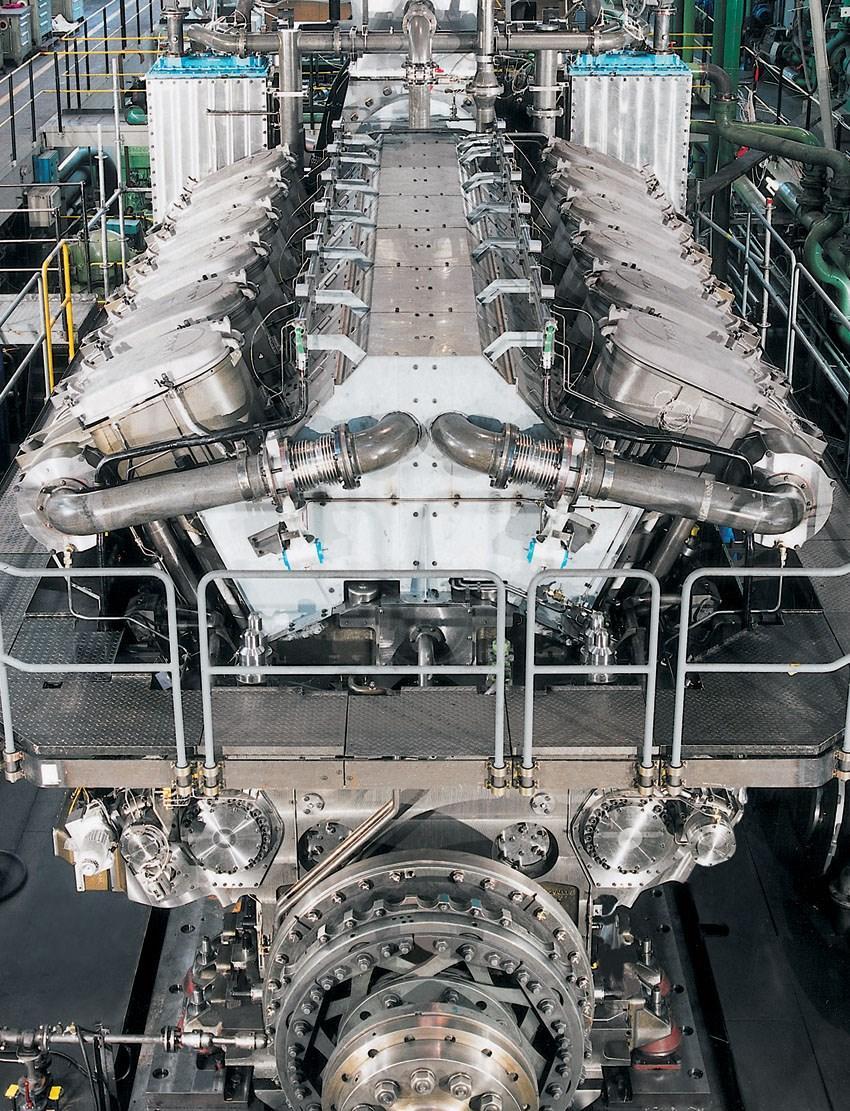
While ships are docked, generators and main engines produce more power than needed. They are turned off in port, and smaller generators supply "hotel" loads (lights, air-conditioning, galley, etc.). Moving through water takes up the vast majority of the ship's power needs - about 85% of all the diesel-electric powerplant production is consumed by the propulsion system. The above photo is of the Vista-class Carnival cruise ship engine room. The engine type is "MAN 2 times; 14V48/60CR" (common-rail diesel injection system):
Cruise ship Emergency Generators
All ships are supplied with emergency generators to maintain vital electrical power. Backup generators are located higher up and also outside engine room spaces to isolate them from damage or fire.
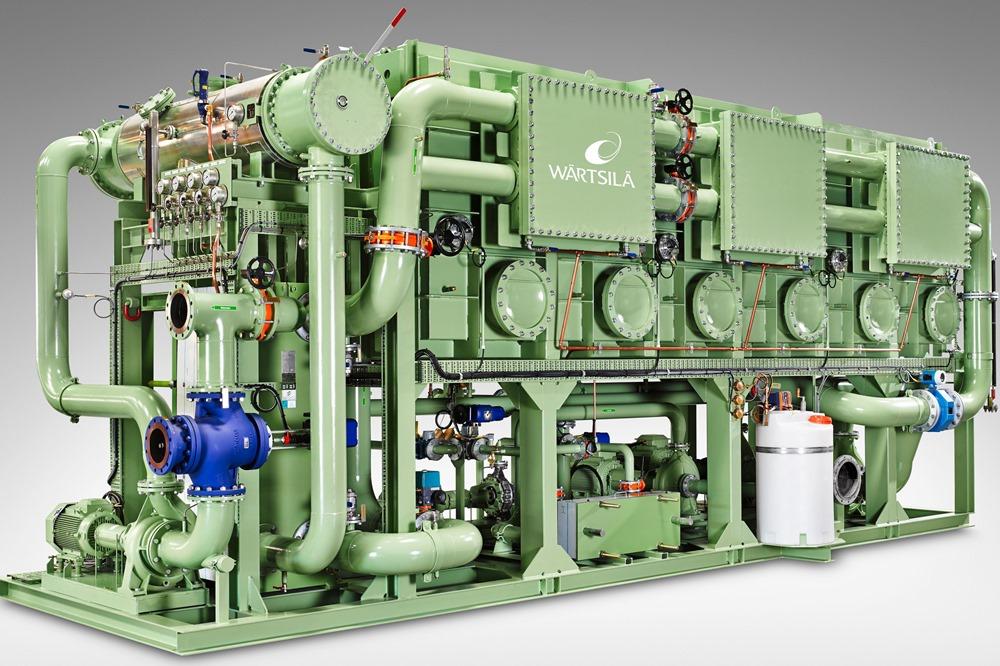
Big ships require much power, so they might have more than one emergency generator. Despite that, they don't have the capacity of main generators and engines, don't produce electricity enough to move the ship, and can't supply all the power needed in ports, because of constraints in space.
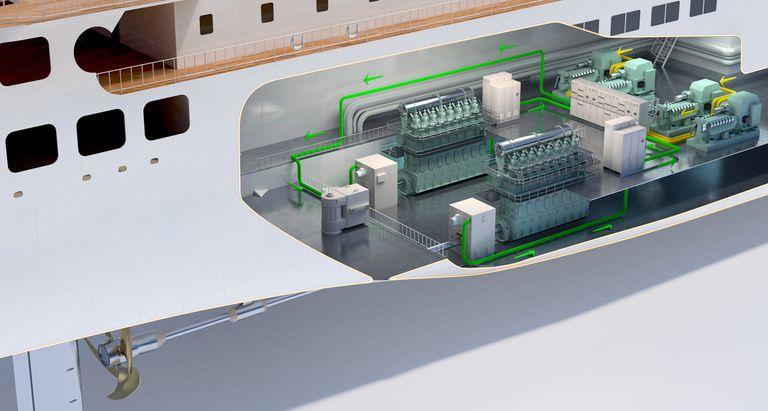
Emergency generators are instead used only for essential navigation systems - crucial communication equipment, critical pumps in the engine room, emergency lighting. Should they also fail, vessels are required to have a battery backup. 24 hours of power are at least provided by battery rooms to the smaller emergency equipment list.
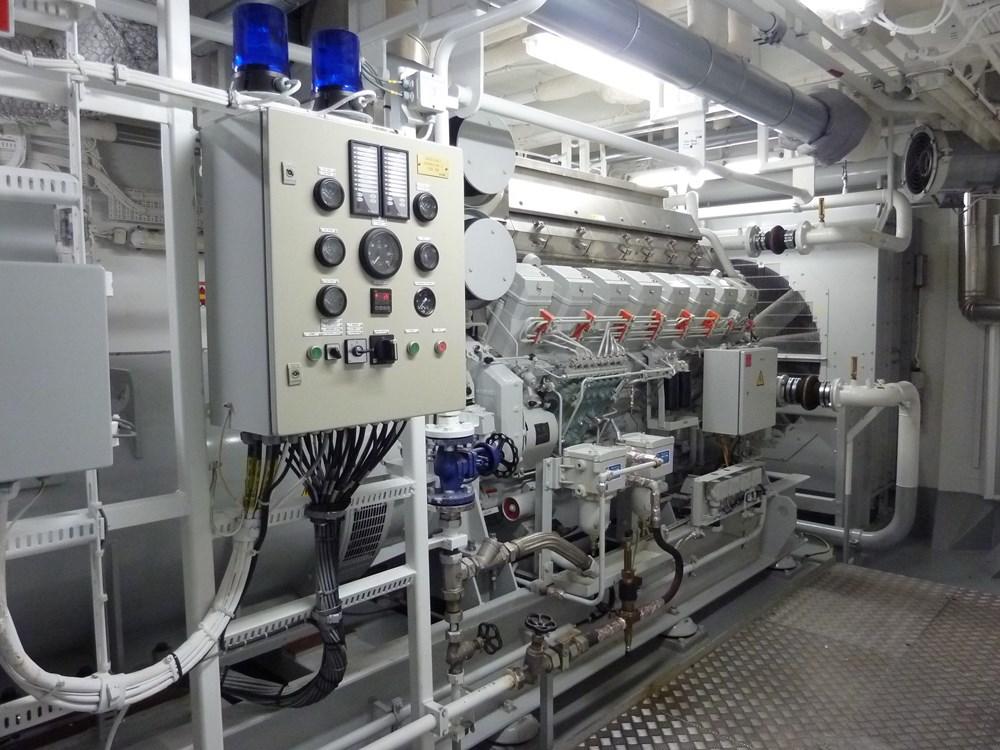
Probably you've heard about Carnival cruise ship accidents related to power failures in 2013. At our Carnival Fun Ship 2.0 upgrades link you can learn how CCL battled with this "unmaintained ships" image and implemented revolutionary new technology initiatives fleetwide - including an additional emergency backup generator on each of their vessels.
Cruise Ship Propulsion
The new cruise ship propulsion systems ABB Azipods XO (below photo) are more fuel-efficient than traditional systems, also providing better maneuverability, maximizing speed, reducing bad emissions, which as a whole optimizes ship's performance and enhances passenger safety.
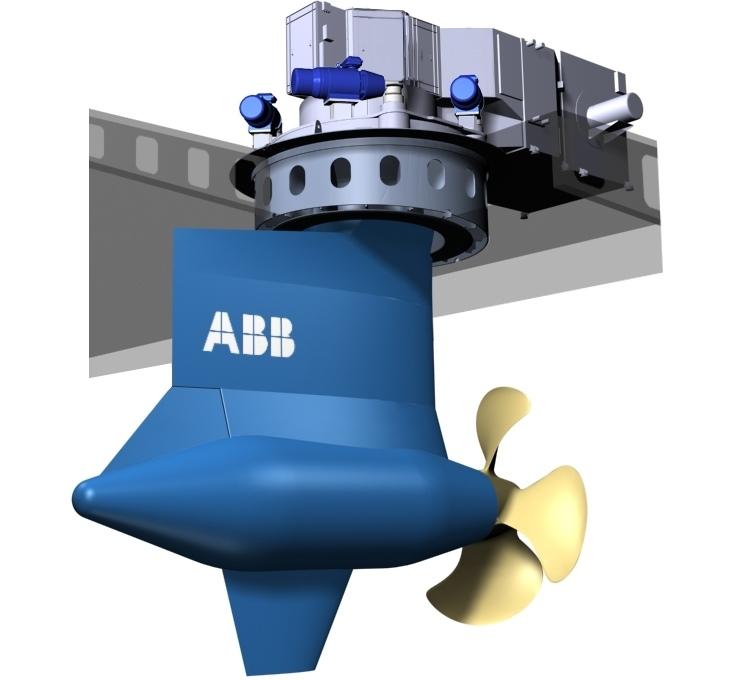
ABB Azipod propulsion systems have a major impact on the vessel's operating efficiency - reducing energy consumption and bad emissions by up to 20%.
In 2019, ABB signed a deal with Oldendorff Carriers (1921-founded, Germany's largest bulk shipping company with a fleet of ~700 ships) for the supply and installation of Azipod propulsion systems on two newbuild carriers. Both self-unloading dry bulk vessels were China-built (by Chengxi Shipyard Co Ltd / subsidiary of CSSC) and scheduled for deliveries in 2021. Each vessel was fitted with two Azipods (power output 1,9 MW per unit) plus various related electric and digital solutions (powerplant, diesel-electric generators, bow thruster motors, transformers, switchboards, power management system, ABB Ability global ABB real-time monitoring).
Azipod cruise ship propulsion system
Azipod cruise ship propulsion system is situated outside the hull in the aft of the ship. Azipod turns in all directions (360 degrees) by a rudder, providing thrust in any directions, not possible for conventional systems.
See at the first photo at right RMS Queen Mary 2's propulsion system scheme.
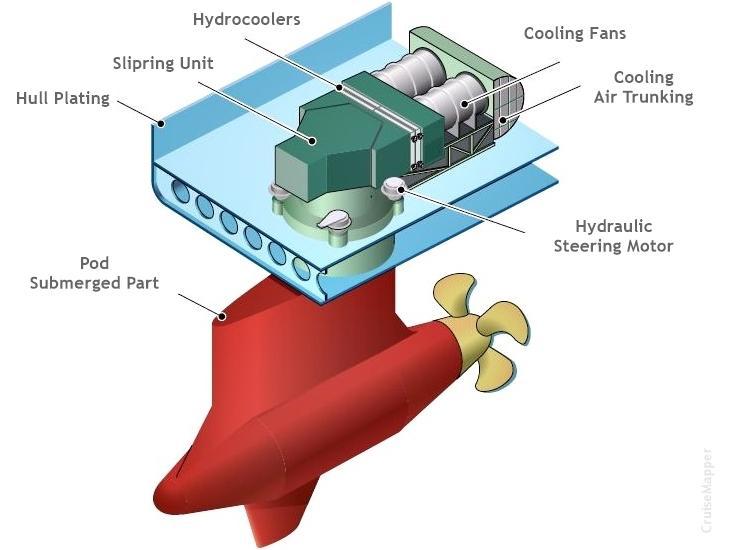
QM2's Azipod is actually an electric propulsion system consisting of the following main components:
- Propulsion motor - used to produce or drive thrust. The propeller's rotating is powered by an electric motor.
- Supply transformer - power produced by generators is 6600 KV, which is stepped down to the necessary voltage by supply transformer and is provided to the motor in the pod.
- Frequency controller - used to change the frequency of supplied power so that the rotating motor speed can be controlled.
Azipod marine ship propulsion is a combination of both steering and propulsion systems. Conventional marine propulsion systems use a two-stroke engine connected to a shaft, that passes through a stern tube and shaft tunnel to connect to the propeller outside the hull in the ship's aft/stern. This system's steering is done by a rudder (in the propeller's aft).
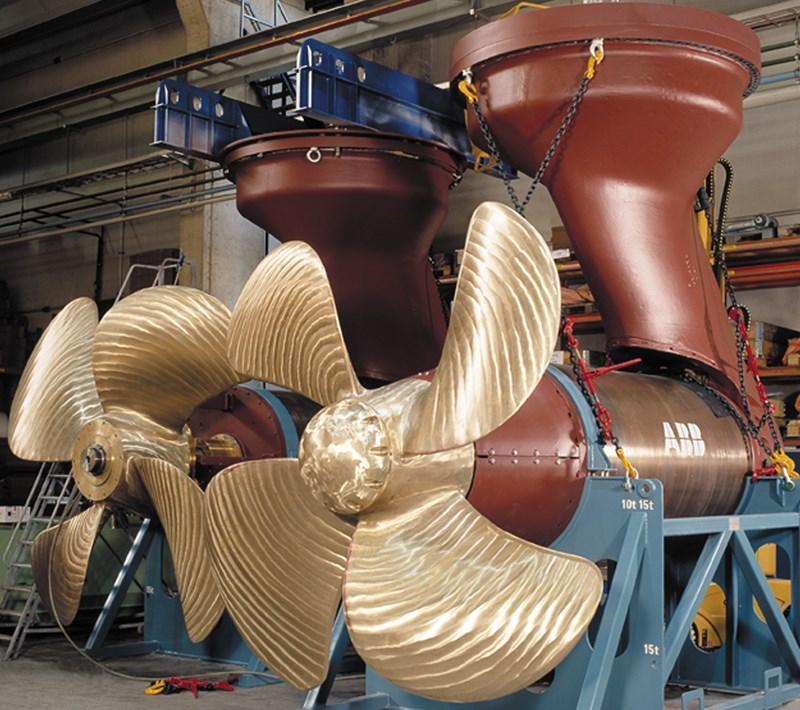
The above photo shows Oasis-class ship propulsion Azipods (2 units) before being mounted onto the hull. The next photo shows the Azipods (both units) mounted on the hull.
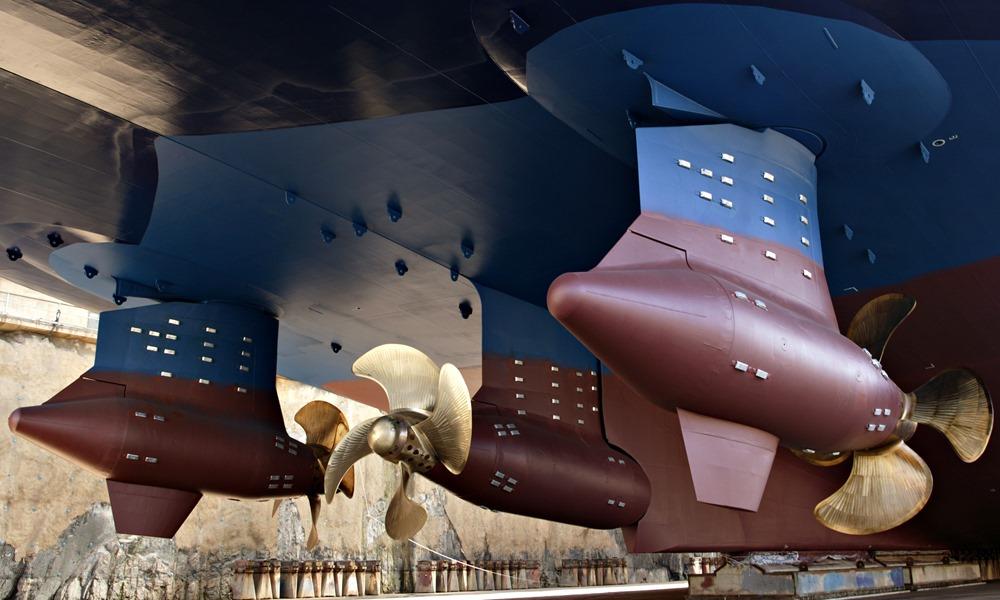
The 3rd Oasis-class ship - Harmony of the Seas, is currently the most technologically advanced and energy-efficient cruise vessel ever built. It is equipped with a new-generation exhaust gas cleaning system (multi-stream scrubbers) and also features a hull lubrication system allowing the ship to float on air bubbles (created around the hull) thus reducing drag and increasing fuel efficiency.
However, the steering and propulsion systems in Azipod arrangement, are combined into one part and the system consists of a propeller (driven by an electrical motor) turned by a rudder connected to the azipod system. The motor is inside the sealed pod and connected to the propeller.
The following YouTube video is about ABB Azipods installed on the new Genting Hong Kong vessels (Star Cruises' new ships and on Crystal Cruises' polar-class boats).
These ships incorporate a complete ABB propulsion - Azipods, electric power plant, computer automation, and software. Crystal cruise ships are powered by two "Azipod D" units allowing navigation in polar destinations. Each of the Star Cruises "Global-Class" vessels have three "Azipod XO" thrusters. All ships have installed ABB's "Intelligent Maneuvering Interface" and the "OCTOPUS" software optimizing fuel consumption and energy management. All these ships were constructed by the German shipbuilder MV Werften. Currently, almost 2/3 of all large-sized cruise vessels, icebreaking ships, and high ice-class cargo ships are with Azipod propulsion.
Advantages of Azipod propulsion marine systems
- A lot of space is saved by the Azipod cruise ship propulsion system in the engine room - there is no propeller, engine, shafting or other arrangements. This saved space can be used for storing cargo.
- Great maneuverability - the propeller can turn in all directions and enables crash maneuvering stop distance that is better than the conventional systems.
- Azipod cruise ship propulsion system can be placed below the ship's height and provide more efficiency than conventional systems.
- In case the ships have large breadth, two (or more) azipod systems, independent from one another, can be used to provide subtle maneuvering.
- Side thruster's use is eliminated as pods can be used to provide side thrust.
- Low lube oil and fuel consumption.
- Lower vibrations and noise than conventional systems.
- Because emissions are low, it's environment-friendly.
Disadvantages of the Azipod marine propulsion
- It requires great initial cost.
- Many diesel generators are needed for producing power.
- The power produced by the motor is limited - the maximum available power now is 21 MW.
- Azipod cruise ship propulsion systems can't be installed in heavy cargo ships that need large motors and a lot of power.
Royal Caribbean Quantum-class cruise ships propulsion
In April 2012 ABB made a USD 60-million contract to provide the Azipod propulsion systems for the new Royal Caribbean ships of the Quantum-class (Quantum, Anthem, Ovation) and Quantum Plus-class (Pulse, Passion). The former name of this vessel design was "Project Sunshine". Builder is Meyer Werft (Papenburg, Germany).
ABB also supplies the power generation, distribution systems, bow thrusters, and of course, the 2 x 20,500 kW propulsion Azipod XO units (at the photo at right), transformers and drives.
NCL Epic ship pod-propulsion
When entering service in 2004, the Cunard's QM2 was the biggest in the world at 150,000 GR tonnes. Her designer Stephen Payne showed the advantages of pod-propulsion giving vessels increased maneuverability. The propellers (screws) of the QM2 ship are mounted on the pods which rotate 360 degrees and provide advanced maneuverability. He made the choice to put pods - though relatively new and yet untested for big ships. Royal Caribbean vessels of Oasis, Freedom, and Voyager classes have pod-propulsion as many other big ships, which is opposed to the fixed traditional screws which push in one direction only.
An interesting fact about cruise ship propulsion is that Norwegian Epic doesn't have pods, though slightly bigger than Queen Mary 2 (at 153,000 GR tonnes), because of NCL concerns about the new technology. Some of the lines (including Celebrity and Cunard) have suffered vessel breakdowns due to pod-bearing failures. Lots of voyages had to be canceled, extensive dry-docking periods were required for pod bearings to be replaced, and NCL didn't want to take the risk.
Currently, NCL Norwegian Epic has two rudders with conventional non-Azipod screws. But how does she manage to maneuver if they can push in one direction only? One option is to make them bigger and more effective when maneuvering, another is to add additional mini-pods or install full-sized pods. Only time will tell if any of these will actually ever happen.
Rolls-Royce cruise ship propulsion system "Promas Lite"
In November 2013, the manufacturing giant Rolls-Royce upgraded Hurtigruten's ship MS Richard With its new "Promas Lite" propulsion system (integrated propeller-rudder system). This is an older ship, and Promas Lite was the perfect choice as it is a combined "propeller-rudder" system increasing the efficiency of older passenger vessels with lesser tonnage. The upgrade significantly reduced Hurtigruten's operating costs on this vessel. The improved propeller efficiency was estimated to be between 11-14% at a cruising speed of 15 knots (17 mph / 28kph).
Promas propulsion integrates propeller, hubcap, rudder bulb and the rudder into a single unit which can increase propulsion's efficiency by 3-8% (1-screw vessels) and by 2-6% (2-screw vessels). It also improves maneuverability, reduces fuel consumption and bad emissions. The new modular technology allows efficient and cost-effective custom-made systems to be built up from various existing and standard parts - mooring winches, anchor cable lifters, warping heads.
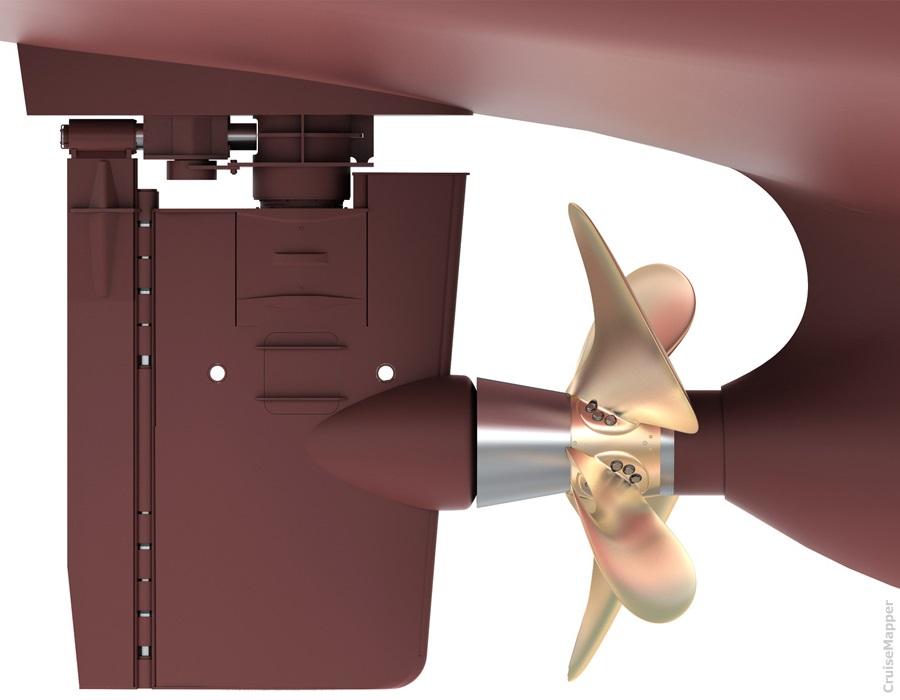
Hurtigruten was compensated with ~80% of its total investment in Promas Lite marine propulsion upgrades as the Norwegian Government has this NOx fund encouraging shipowners and operators to upgrade their vessels and invest in new marine technologies that reduce NOx emissions. The Promas Lite propulsion future clients, besides passenger ships, are marine vessels like fishing and freighter ships.
After Norwegian Spirit (the first ship in NCL fleet with installed Promas Lite in 2011), in May 2014 the Star Cruises ship SuperStar Virgo became Southeast Asia's first passenger liner with RR's Promas Lite propulsion. Fincantieri used Promas Lite propulsion for all Viking Ocean liners.
Cruise Ship Power
The cruise ship engine power is responsible for driving propellers, and the other possibility is producing electricity that is used subsequently to drive propellers. The engine's effectiveness depends not only on the design but also the ship's shape, weight, and size. Power is measured in horsepower traditionally - one horsepower equals 746 watts. The next photo shows the world's largest passenger ships' engine that powers each of the Royal Caribbean Oasis-class vessels.
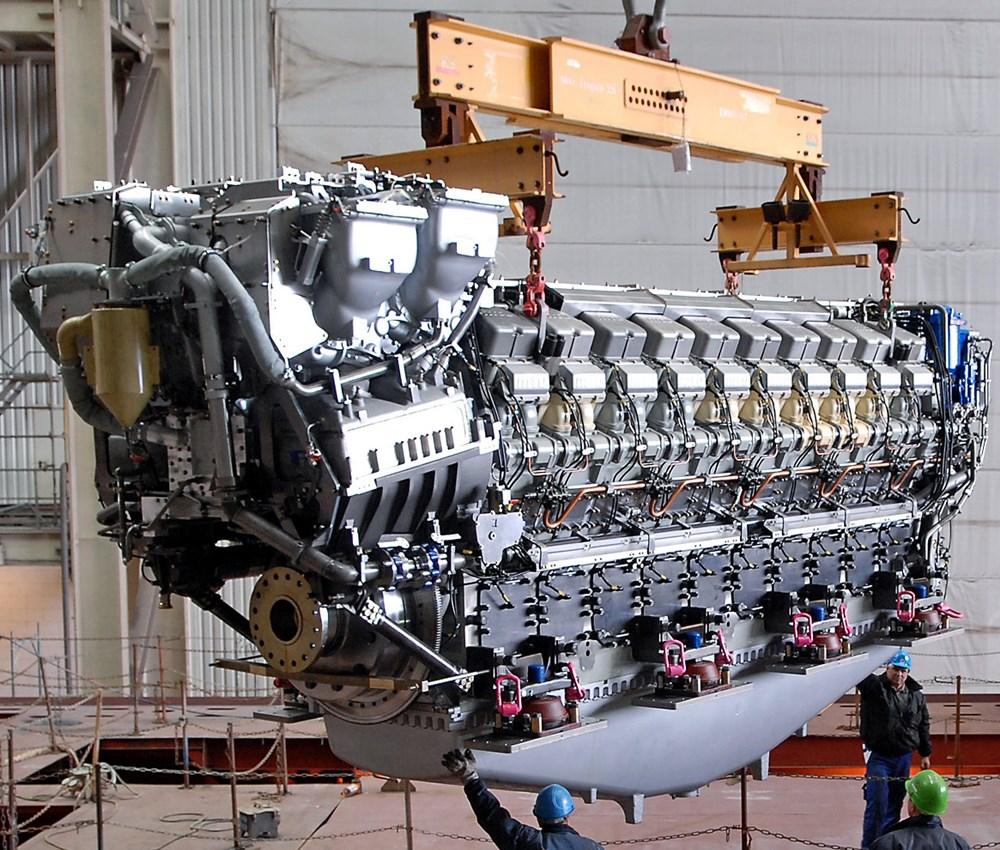
Marine steam engines
The cruise industry began in 1844, when ships were propelled by steam engines, performing the driving of propellers by using steam as working fluid. The largest passenger steamship (before hitting an iceberg on April 14, 1912) was the Titanic, powered by both reciprocating engines and turbines, able to generate 50,000 horsepower (37 megawatts).
Marine diesel engines
Usually, ships are powered by four or five generator sets (medium-speed, 500 revolutions per minute), fueled by diesel and creating 8-10 MW energy each. The power density of marine diesel medium-speed engine is 80 kilowatts per cubic meter. Ships that use diesel engines are required to carry exhaust-treatment systems and catalytic-reduction equipment to reduce the environmental impact.
Marine nuclear power engines
The building of the US first and only merchant nuclear-powered ship was commissioned in the 1950s by President Eisenhower. Of total cost $46.9 million, on the fuel core and nuclear reactor was spent more than $28 million. The ship operated only for five years (1965-1970) but due to the high running costs, its service was terminated.
Marine gas turbines
The first company that fitted cruise vessels with gas turbines, was Royal Caribbean. Gas turbines are greener than diesel engines and allow ships to sail with reduced inventory and smaller maintenance crew. Gas turbines drive generators which in turn provide electricity to propeller motors. They recover heat from gas turbines' exhaust, which then is used to produce the electricity needed for onboard services (air conditioning, water heating).
Rolls Royce is the manufacturer of the world's largest GAS marine turbine "Rolls-Royce MT30". The turbine will provide the immense 109 MW of power for the 2 propellers, all the weaponry, radars, command sys, etc. of the new generation UK aircraft carriers of the Queen Elizabeth class. To this class belong HMS Queen Elizabeth (2017-commissioned) and HMS Prince of Wales (2019-commissioned), each of them with a total power consumption of 80 MW.
Gas-turbine cruise ship power system
The first large vessel to use a new gas-turbine cruise ship propulsion system was Celebrity Millennium. This system will be more frequently used in new cruise ship buildings. It's innovative and, besides new activities available, the economy of scale, marketing, represents an important element of ship design. System's advantages include:
- lower vibrations and noise level, better comfort, lower probability of failure;
- lower exploitation costs because of the easier maintenance;
- nocive emissions reduction, which is partially owed to gas oil instead of fuel (-90% oxide of sulfur, -80% oxide of azote).
- considerable gain of weight and volume, especially when with Azipod marine propulsion system (900 tons, 70 cabins added).
Gas turbines at this time are only interesting in the building of high-speed ships (warships, and especially aircraft carriers, or fast passenger vessels - Millennium max speed is 25kn), because of the better diesel output in lower speeds and higher price of gasoil instead of fuel for diesel engines.
Gas turbine cruise ship propulsion systems are able to avoid pre-heating systems needed for fuel in classic installations (risk of fire!), as they use gasoil, Celebrity's Millenium-class and RCI's Radiance-class use such turbine powerplants. The next photo shows Celebrity's Solstice-class ship propulsion (the 4 aft azipods, and the underwater hull shape).
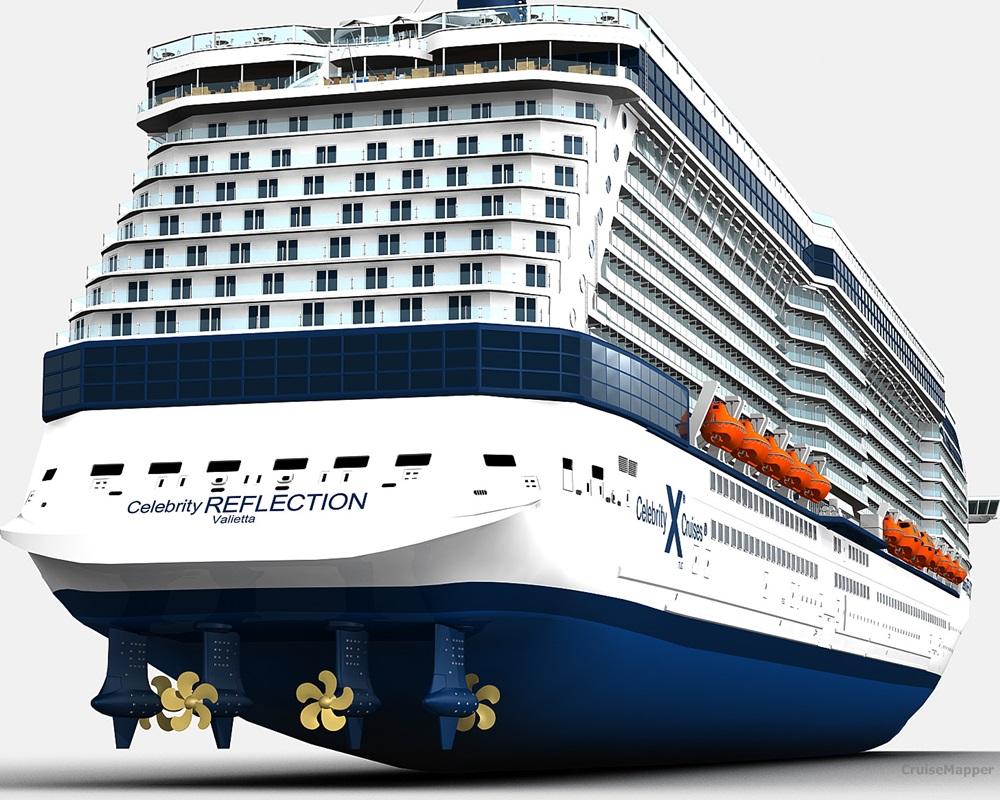
LNG-powered cruise ships
In June 2015, Carnival Corporation announced the company's contract with Fincantieri to build four LNG-powered vessels with the industry's largest passenger capacity. This was part of the order with Meyer Werft and Fincantieri for a total of 9x units to be built in the period 2019-2022.
The four newbuilds became the industry's first LNG (Liquefied Natural Gas) powered vessels using LNG in their hybrid engines. The gas is stored in the ship and used to generate all needed power at sea. The engines are not exclusively LNG, but "dual fuel" (capable of burring both liquid marine fuel and natural gas). This design is for saving onboard space (reducing fuel storage space required).
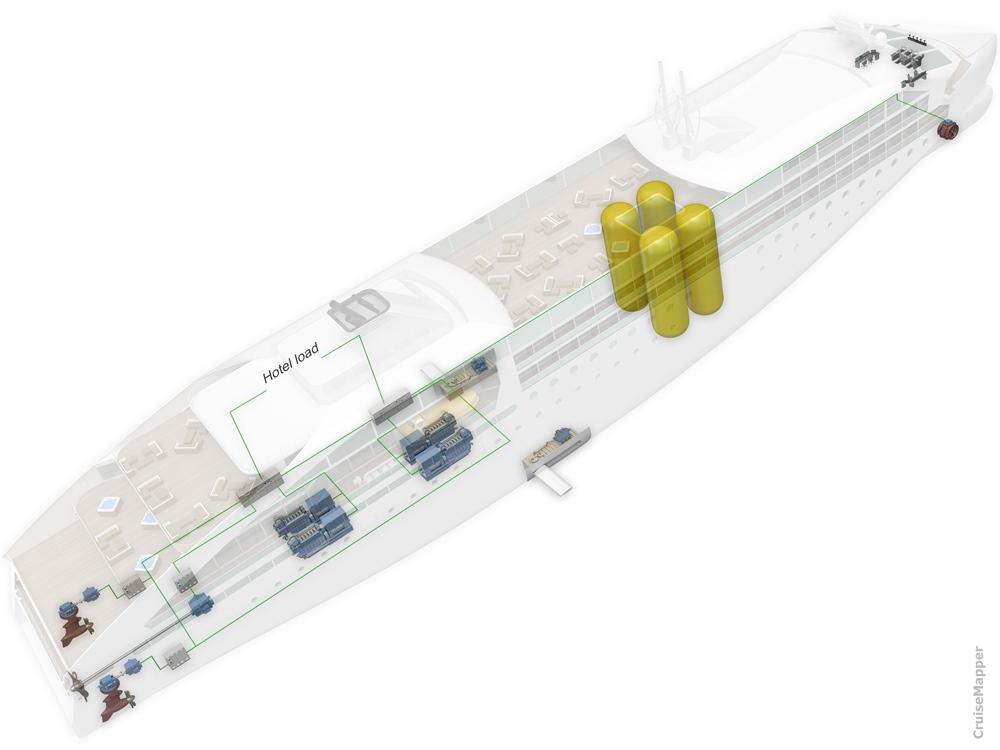
LNG is natural gas, which consists of 90% methane and 10% ethane. When cooled to -160 C, it passes from gas to liquid, and its volume decreases over 600 times, making it very efficient for distribution. Long-distance LNG transportation is via dual-hull gas carriers. Short-distance LNG transportation is via trucks or smaller vessels (also barges) fitted with high-pressure tanks.
Gas fuel eliminates all the bad emissions - soot and sulfur oxides. In April 2016 MSC Cruises announced its contract with STX France for up to four LNG-powered ships with GT over 200,000 tons each. For comparison, the Oasis of the Seas is 225,000 GT tons. The new MSC ships have 5400 passengers capacity at double occupancy each. The first one is scheduled for delivery in 2022. Its power plant will be based on a new prototype engine.
Using LNG to power large cruise ships is a relatively new (2016) concept. Due to LNG tanks' large sizes, this fuel is used usually on smaller passenger shipping vessels (ferries) operating on short crossing itineraries. LNG bunkering facilities available in ports are very few. Compared to other fuels (including MGO / marine gas oil), LNG is purer (no unburned residues, fewer greenhouse gases), more efficient, stable and cheaper (reduces fuel costs). LNG technology also advances due to IMO's future maritime emissions regulations, especially in ports and while operating in environmentally sensitive destinations.
In comparison to pipeline gas, LNG is superior in quality - purer, with more methane and other energy content. Its chemical structure also has a stable composition that doesn't generate unburned residues, soot or any particulates. In addition, because the fuel is so clean, on LNG-powered ships maintenance intervals are doubled (over 25,000 hours / ~10140 days), as opposed to the standard MDO-powered 12,500 hours (520 days).
- All the world's major environmental organizations and the marine shipping industry joined for an explicit prohibition on the carriage of non-compliant fuels when the 0,5% sulfur cap takes effect in 2020.
- In January 2018, IMO announced that starting January 1, 2020, the marine fuels' max allowed sulfur content (outside Emission Control Areas) is reduced from the previous 3,5% to 0,5%. Unless marine vessels are using approved equivalent compliance methods, after Jan 2020 there is no reason for ships to use non-compliant diesel fuels.
- IMO's new sulfur cap's goal is to provide substantial health benefits by reducing marine fuels' sulfur content (SOx gases). At the same time, IMO's lowered cap significantly increases ships' operating costs.
The LNG cruise ship concept was first introduced by Wartsila (Finnish manufacturing company) and is based on drive shaft propulsion instead of azipods. The LNG tanks' location is in the upper deck area (right below the funnels). The Rolls Royce concept is based on azipods.
AIDAprima (2016) is one of the world's most technologically advanced cruise vessels. The ship rides on a cushion of air, thus reducing frictions and fuel consumption, The new technology is called MALS ("Mitsubishi Air Lubrication System"), allowing the liner to glide on an air bubbles carpet.
The ship's 4 main engines are dual-fuel (heavy oil and LNG gas oil) thus reducing fuel consumption. The ship has an advanced filtering system that reduces stack emissions (greenhouse gases). The ship's propulsion features 1 pair of stabilizers and 2x ABB-pod drives (new XO-Pod series, power output per unit: is 3 MW). The total power output is 48 MW. AIDAprima is also the world's first-ever "LNG cruise ship" as it uses LNG fuel supply while berthed in ports.
For its LNG-bunkering operations in Florida (at homeports PortMiami and Port Canaveral), CCL-Carnival partnered with Royal Dutch Shell plc as fuel supplier for the liners Mardi Gras (2021) and Celebration (2022).
AIDA's LNG-powered cruise ships
The AIDAprima ship's first successful test run for LNG supply was in Hamburg Germany on May 7, 2016. While berthed, the ship was successfully provided with LNG at all the itinerary's ports of call (Hamburg, Rotterdam, Le Havre, Southampton, Zeebrugge).
- The company's statistics show that the AIDA ship spends about 40% of its operating time in ports. Compared to using conventional marine diesel (0,1% sulfur content), by using LNG, the vessel's emissions were considerably reduced even further. Sulfur oxides and soot particles were prevented completely (while in port), nitrogen oxide emission was reduced by up to 80%, CO2 emissions were lowered by 20%.
- AIDA ships (produced by Shipyard Papenburg) are 100% LNG-powered. AIDA invested in research and testing of LNG cruise ship technologies since 2015. In 2013, AIDA collaborated on LNG hybrid barges with Becker Marine Systems. The innovative and flexible solution is used on ships moored in Port Hamburg.
- Since May 30, 2015, AIDAsol is regularly supplied with low-emission LNG power at Hamburg's Hafencity Cruise Terminal.
- AIDA ships use just 3 liters (0,8 US gallons) of fuel on average per person on board for a 100 km (62 ml) trip. This was confirmed by an independent expert study in 2012. Following the implementation of new technologies and economical handling of resources, the company's statistics for 2016 (over 2012) showed reduced energy consumption (9% per person onboard), reduced water consumption (7,2% pp) and reduced CO2 emissions (7,7% pp).
Hurtigruten ships
In April 2018, the Norwegian cruise and ferry company Hurtigruten announced a USD 150 million fleet renovation project. Almost all vessels will be upgraded with new hybrid powerplants that combine LNG-engines and batteries.
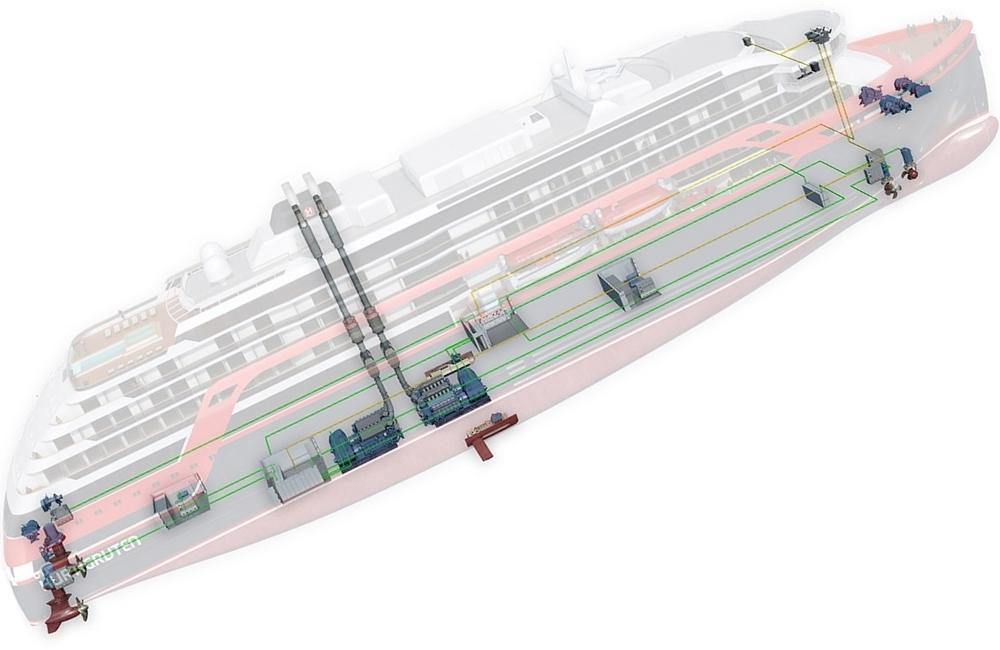
For the project was contracted Rolls-Royce Marine, initially for 6 ships plus optional another 3. The program's completion was scheduled before January 1, 2021. The project also includes all vessels to be upgraded with shore power capabilities.
Dual-engine ferries (LNG-MDO)
The next scheme shows the dual-engine powerplant (Wartsila) and propulsion (Azipod) of the cruise ferryTallink Megastar. This ship is the biggest "floating superstore" on the Baltic Sea, featuring a 2-deck retail shopping complex and the unique self-service option called "Q-shopping". The RoPax vessel uses LNG as prime fuel and MDO (marine diesel oil) as secondary fuel.
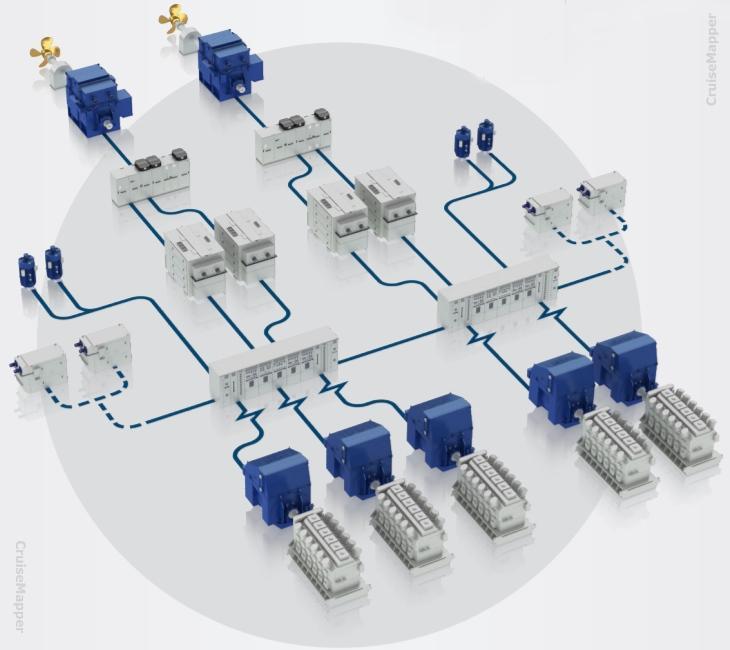
The ship is powered by a total of five Wartsila dual-fuel engines - three 12-cylinder (model 12V50DF, combined output 34,2 MW) plus two 6-cylinder (model 6L50DF, combined output 11,4 MW). Ferryboat's total power output is 45,6 MW. Its propulsion system includes two Wartsila fixed-pitch propellers with twin propeller shafts. Navigation systems are also Wartsila-made, including NACOS Platinum (integrated vessel control system).
The power generated by the main engines/powerplant produces electricity that is used from the propulsion motors, as well as all auxiliary systems and hotel functions. This innovative maritime technology allows the engines to be started and stopped depending on the onboard electricity demand, which additionally improves fuel efficiency.
Vessel's hull is ice-strengthened (class 1A). Rudders are from Becker Marine Systems. When compared to traditional marine engines, in gas mode, the ship's engines produce 1/4 less COx, 2/3 less NOx, zero SOx and no soot particles.
The onboard LNG system consists of 2 bunker stations, 2 horizontal LNG storage tanks by Linde (cryogenic, vacuum-insulated, stainless steel, total gas volume 600 m3), double-walled bunkering lines, pipelines (acid-proof stainless steel), special pipe fittings, gas distribution system, steam boilers. All the ship's electrical equipment is certified "explosion-proof". The LNG is stored at temperatures -160 Celsius (-256 Fahrenheit) and under pressure 4-6 bars.
ABB supplied the vessel's power and electric propulsion systems, as well as the Octopus (smart energy management system). While mechanical propulsion is optimized for a single-speed, electric propulsion is based on rotating speed control resulting in energy efficiency at all speeds. ABB's propulsion also improves passenger comfort as the ship runs much more quietly and smoothly. ABB's Octopus marine technology allows real-time monitoring of the vessel's energy (and fuel) consumption. Based on the collected data, the software suggests optimal performance recommendations.
Spain's first LNG-powered cruiseferry was Hypatia de Alejandria (2019) owned by BALEARIA.
Wind-assisted propulsion
On April 12, 2018, the VIKING LINE-owned ferry Viking Grace became the world's first-ever passenger ship equipped with a rotor sail utilizing wind power. This also made it the world's first hybrid vessel that uses both wind power and dual-fuel (diesel-gas) engines.
"Rotor Sail Solution" is an innovative technology developed by the company Norsepower Ltd (Finland) in 5 years. It reduces fuel consumption and also COx emissions up to 900 tons per year (depending on wind conditions).
The cylindrical rotor sail has a height of 24 m (79 ft) and a diameter of 4 m (13 ft). The technology is based on the "Flettner rotor" (patented by Anton Flettner in 1922) and uses the so-called "Magnus effect" - the spinning rotor (rotating cylinder) drags airflow faster around one side. This creates pressure/speed difference that moves it in the direction of the opposite (lower-pressure) side, creating a force at a right angle to the direction of the wind. This wind-assisted propulsion power drives the ship forward. Unlike traditional cloth sails, the rotor needs no furling (stowing), reefing (reducing sail's area) or line-tending. The rotor sail system is automated and shuts down when unfavorable changes in wind force or direction occur.
Added to the dual-fuel engines, the new technology makes Viking Grace one of the world's most environmentally-friendly passenger ships, operating with very low levels of emissions and noise. Norsepower's wind propulsion system was also installed on VIKING LINE's newest vessel (still unnamed) scheduled for delivery in 2020. The China-built ferryboat is equipped with two Norsepower-produced rotor sails, doubling its wind power potential.
Ship's powerplant includes 4x Wartsila engines (model 8L50DF, total power output 30,4 MW). Propulsion is diesel-electric (2x shafts with fixed-pitch propellers) and wind-assisted (with 1x rotor sail). Engines are dual-fuel (MDO-LNG). As gas tanks are larger than marine fuel tanks. they need 6 times more space. To save hull space, LNG tanks are located on an open deck. LNG tanks are two (type C / vacuum insulated), each with capacity 200 m3 and weight 140 tons (LNG weight 85 tons per tank).
MS Viking Grace is also the world's first ship with the energy recycling system "Ocean Marine" (developed by Climeon AB / Stockholm-based company). The system converts the excess heat (generated by engines and exhausts) into clean (emission-free) electricity with an annual capacity of 700,000 kWh. This electricity is primarily used on cabin decks (including for heating, hot water, lighting). The technology uses heat exchangers that evaporate a carrier fluid circulating in a closed system. This gas (at 2-bar pressure) drives a turbine, then a 100 kW generator produces electricity. After that, the gas is cooled (in a vacuum chamber) and liquefied. Cooling is rapid, as the cold fluid is sprayed out. Then Heat exchangers cool the carrier fluid to temperatures around 20 C / 68 F.
Cruise Ship Fuel Consumption
How much fuel do cruise ships use?
Cruise ship fuel consumption depends on the ship's size. For most vessels, the average consumption is 30-50 miles on a fuel gallon. This will be also determined by other factors using fuel. Ships' gas mileage varies depending on the type and size of ship, the number of passengers on board, and other factors. Larger ships need more fuel to move through the water.
How much fuel do cruise ships use?
RMS Queen Mary uses 6 tons of marine fuel per hour. Celebrity Eclipse gets 56 feet to the gallon. MS Zuiderdam - .0130 miles per gallon (0.34 tons fuel per mile). This may not seem very good mileage at first glance, however, cruise ships are moving at once thousands of people whereas a car is moving a few.
Nearly all contemporary cruise ships are powered by electricity (motors turn propellers). It powers the air conditioning systems, lights and all other appliances aboard the ship. Most vessels produce the electricity they need by using diesel engines. Some use gas turbine engines. Others use a combination of the two. HFO (heavy fuel oil) is used by diesel engines, while MGO (marine gas oil) is used by gas turbine engines. The MGO is similar to the jet airplanes' fuel.
Speed affects cruise ship fuel consumption because to go faster, vessels must increase the electricity flow to motors. Thus more engines are employed, and it, in turn, increases fuel consumption. For example, Queen Mary 2 consumes 237 tons MGO and 261 tons HFO a day when at full speed. After a certain point, the rate of return decreases from adding engines, because if a ship can manage 17 knots by two engines, it doesn't mean that four engines are going to produce 34 knots.
Cruise companies employ new technologies in order to reduce fuel consumption. Ship's hull, for example, can be applied by silicon coating in order to reduce friction as the ship goes through the water. Friction reduction on Celebrity Eclipse is 5%. Another experiment is LED lighting, using less energy and producing less heat (thus is reduced the demand for electricity and air conditioning). Celebrity Solstice-class vessels have solar panels' field over the AquaSpa pool area. This not only provides shade for the pool area but produced by solar panels electricity is used to decrease the electricity demand from the engines.
RMS Queen Mary 2 is equipped with exhaust gas economizers, using waste heat from engines to produce steam. Then steam is used to heat fuel and QM2 hotel accommodations, laundry, galleys. This reduces the energy amount that has to be produced by ship's engines. The Promas Lite system (mentioned above) generates cruise ship fuel savings in the range of 5-15% depending on the operation type and the actual performance of the ship's existing propeller.
How marine ships fuel consumption increases at higher speeds? Next infographic shows the speed-fuel consumption relation on container ships (their sizes are measured in TEU-containers/20 ft equivalent units), which are similar by speeds and even gross tonnage to cruise passenger ships.
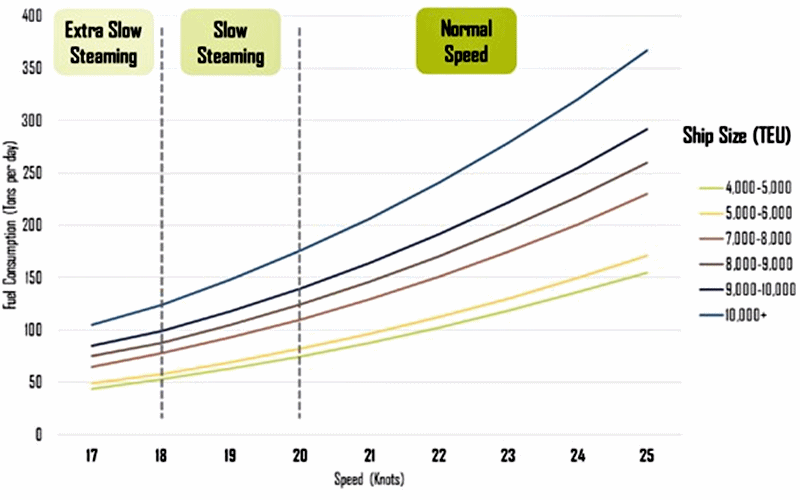
Cruise Ship Pollution
Today cruising is one of the most popular vacations, but there are significant environmental downsides. Mega-ships burn the dirtiest fuel in the world, even if they are sitting in port. Asthma, cancer, respiratory illness, heart disease, are the results of burned in ports nasty bunker fuel.
Shore-to-Ship Power Supply
Those who support the cruise industry point out that cruising has never been more popular. However, more ships generate more pollution. A solution is to have docked vessels plug into the port's shore power grid. Most of the world's largest cruise ports have such dockside electrical hookups, reducing bad emissions by up to 95%.
Aka "cold ironing" and "shore-to-ship power", shore power capability allows berthed cruise ships to shut down their diesel engines (main and auxiliary) and plug into city's electrical grid, using locally-produced electricity for all shipboard equipment and services - including cooling, heating, lighting, emergency, etc. The technology greatly reduces exhaust emissions in seaports. Next video animation reviews this technology.
TUI Cruises Ships Environmental Report
TUI published the company's environmental impact report (first of its kind) including environmental objectives and TUI strategy for a 5-years period. TUI said it planned to issue reports every 2 years. According to it, in 2012 TUI reduced by 3.7% per nautical mile its fuel consumption, and expects further 5% reduction, reducing CO2 emission at the same time by 0.5 kg to 0.55 kg per traveler.
Energy efficiencies are the key to reduce fuel consumption, CO2, and other emissions, and contribute to climate protection. Mein Schiff 3, for example, is expected to feature special energy management systems that help to consume 30% less energy than comparable size ships. TUI is focused on reducing recycling and waste, too. In 2012, TUI reduced the waste amount to 10,7 L (per passenger day), which is 27,8% less (over 2011). In 2012, TUI used 54,463 tons of fuel, including 9,732 tons LSFO (low sulfur fuel oil), 40,880 tons HFO (heavy fuel oil) and 3,851 tons MDO (marine diesel oil). Fuel consumption was 0,367 tons per nautical mile.
All new TUI ships are built to the latest standards with environmentally-friendly marine technologies. These vessels, both as design (hull and superstructure) and implemented technologies, are highly energy-efficient. Each consumes 1/3 less energy compared to most cruise liners. The advanced exhaust cleaning system uses a catalytic and scrubber converter. This technology allows sulfur emissions to be reduced by 99%, and NOx emissions - by 75%.
All-electric passenger ships
In May 2019, the US company "Maid of the Mist" ordered ABB two new all-electric vessels for the company's Niagara Falls tours. Both catamarans are 100% emission-free being powered by high-capacity batteries. Each ship is fitted with two battery packs (combined capacity 316 kWh / 563 HP output). The electricity is provided by 2 fully-independent power systems and split evenly between the 2 hulls.
Shoreside battery charging takes just 7 min (per ship). The powerplant is controlled by ABB's PEMS (Power and Energy Management System), which also optimizes the onboard energy use. Ships' batteries are charged using hydropower (water-generated electricity), which as of 2019 accounts for ~7% of the USA's total electricity production. In addition to the shoreside charging connection, ABB supplied the newbuilds with switchboards, motors, integrated control systems and ABB Ability's Marine Remote Diagnostic System (24-hour equipment monitoring and predictive maintenance).
Battery power is used during turnaround navigation in ports when the onboard diesel-electric generators are switched off. For ferry batteries (fabrication, delivery, and installation) is often contracted the Canadian company Corvus Energy (Richmond BC) - one of the world's largest manufacturers and suppliers of energy storage solutions (ESS) for the maritime industry. The company provides ESS to hybrid and all-electric ferries. As of 2019, Corvus Energy delivered its innovative product line "Orca ESS" to 200+ vessel conversion/upgrade projects, totaling 200+ MWh.
At the following tag-link can be found listed all CruiseMapper's news related to propulsion-power accidents.
This cruise vessel technology-related survey is integrated with our articles on passenger ships building and safety, and the statistical ones about registry/flag-states, cost to build, speed, passenger capacity. All ship links redirect to the vessel's "itinerary-schedule-current position" page.